Detroit didn’t kill the Tucker 48
Posted on May 11, 2021 in Featured | 2 comments
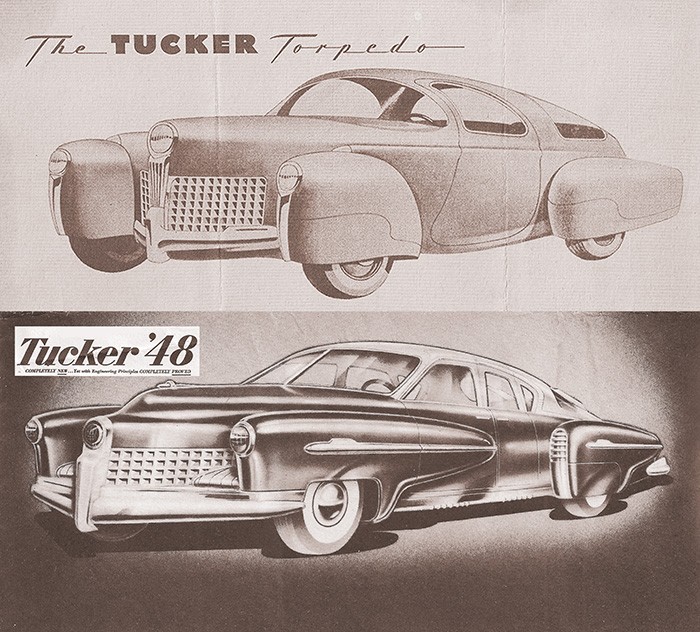
Earliest proposal by ex-GM designer George Lawson was called the Tin Goose, had pivoting, skirted front fenders. Tin Goose sketches appeared in early ads (below), but later ads showed Alex Tremulis’s updated Tucker drawing.
Forget the movie. Forget the legend. Detroit did not put Preston Tucker out of business. What killed Tucker in 1948 was a simple lack of money.
Preston Tucker ultimately raised about $26 million. Financial historians have estimated that Tucker would have needed at least $100 million to even come close to succeeding. They based that estimate partly on the vast sums that Kaiser-Frazer burned through between 1946 and 1954, noting that Henry J. Kaiser was a respected industrialist with a good ties to bankers, suppliers, unions and distributors. Preston Tucker had nothing comparable.

Preston Tucker had charm and charisma in spades, but lacked the financial backing he would need to produce an automobile.
What Tucker did have was movie-star looks and a flair for salesmanship. He stood 6-2, was athletic, friendly, charming and highly confident. Born on a Michigan farm in 1903, he learned to drive at 11, became an office boy at Cadillac in his teens, then sold Pierce-Arrows, Stutzes, Studebakers, Chryslers, Dodges and Packards when he wasn’t working as a Detroit-area policeman. His mother said he joined the police force so he could drive fast patrol cars legally.

Tucker 48 belonging to the National Automobile Museum in Reno appeared at last year’s Ironstone Concours d’Elegance in Murphys, California. Wayne Craig photo.
His fascination with fast cars took him to the Indianapolis 500 every year, and there, in 1926, Tucker met his idol, Harry Miller. Miller at that time engineered and built some of the world’s winningest race cars. In the 1930s, Miller and Tucker teamed up to assemble and promote, among other projects, the infamous team of 1935 front-wheel-drive Miller Ford V-8 Indy race cars.
During the early years of World War II, and before Miller’s 1943 death from cancer, the pair dreamed up a radical passenger car, one with a huge, slow-revving engine set crosswise between the rear wheels. The crankshaft attached to stub axles, and each wheel would be driven by a hydraulic torque converter. The fuel-injected, 589-cu.in. engine would develop 450-lb.ft. of torque at a mere 1,800 RPM. At that engine speed, Miller calculated, the car would be cruising along at 100-110 MPH.

Tucker engineer Ben Parsons initially tried to power the Tin Goose with a 589-cu.in. flat-six. When that didn’t work, he converted Franklin helicopter engines to water cooling and mated them to 1936-’37 Cord four-speed transaxles. Michael Lamm photo.
After the war, Tucker hired engineer Ben Parsons to build the 589-cu.in. engine. This six-cylinder horizontally opposed powerplant, along with many of the innovations Miller and Tucker had talked about, appeared in a running prototype called the Tin Goose. Tucker promptly announced that he planned to market a sedan based on the Tin Goose. The production car, he said, would be built in one of the world’s largest factories, the former Dodge B-29 engine plant near Chicago, which he’d managed to lease from the government.
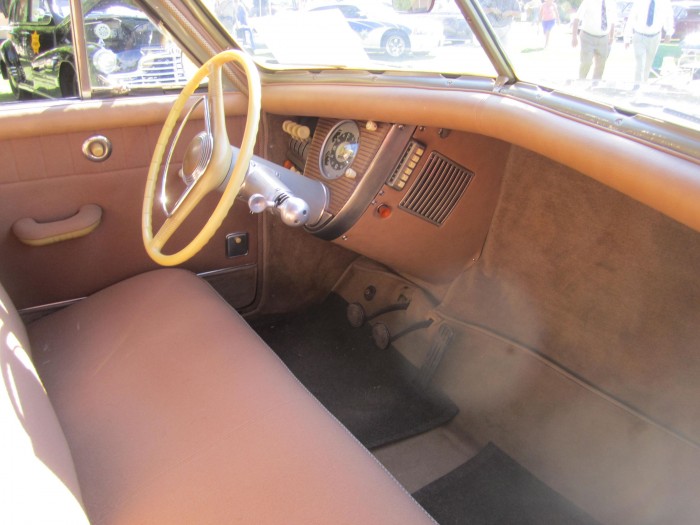
Tucker’s front passengers could duck into a “crash compartment” if they saw a collision coming. The Cord pre-selector stood on the steering column. Michael Lamm photo.
The 1948 Tucker prospectus touted safety. The all-new Tucker would have clutch-type disc brakes, seatbelts, a padded dash, a recessed “crash compartment” for front passengers, a pop-out windshield and a central headlight that turned with the front wheels. His sales vice president, however, nixed the seatbelts, saying they implied danger.
The Tucker Torpedo, as it was initially called (later changed to Tucker 48) would carry six people and get exceptional fuel mileage. After World War II, car-starved Americans eagerly believed Preston Tucker as he promoted the Torpedo’s style and advanced engineering. As reality set in, though, it quickly became clear that the 589-cu.in. engine and its two torque converters wouldn’t work. Nor did the disc brakes. Tucker substituted an opposed, six-cylinder Franklin helicopter engine converted to water cooling. At 166 bhp, the Tucker engine packed more punch than any car offered by Detroit that year.
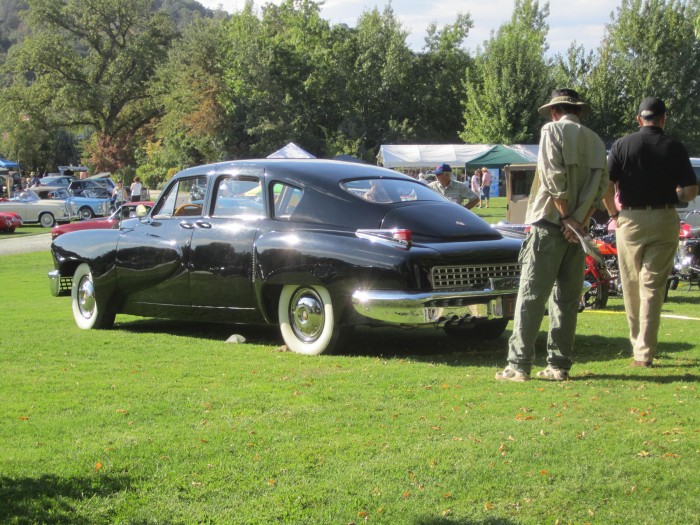
Author Lamm drove Gene Clarke’s 1948 Tucker in 1973 for a driveReport in Special-Interest Autos (SIA #14). Clarke’s car is shown here 42 years later at the Ironstone Concours d’Elegance. Michael Lamm photo.
Tucker employees, meanwhile, scoured the nation’s salvage yards for transaxles from wrecked 1936-’37 Cords. These four-speed, pre-selector gearboxes were refurbished and installed in prototype Tuckers.
In 1946, Preston Tucker hired Alex Tremulis and Gordon A. Lippencott (in 1947) to restyle the Tin Goose and make it more mainstream. Madly, furiously, hundreds of craftsmen cobbled together 51 running pilot models. The plan was to build 100 test vehicles, each incorporating improvements gleaned from previous cars. One car even flipped during testing at the Indianapolis speedway, but no one was hurt and the car survived.
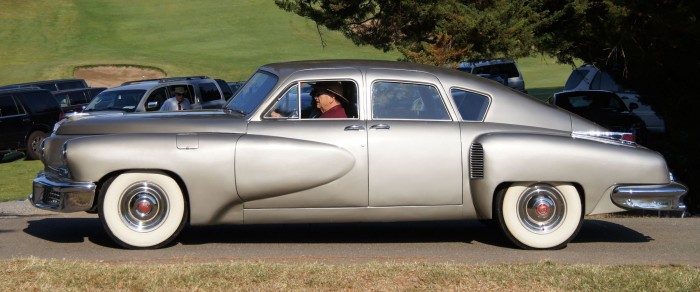
National Automobile Museum’s Tucker was one of three shown last September at the Ironstone Concours d’Elegance. This was the Harrah car that Lamm drove initially in 1971. Wayne Craig photo.
Tucker tried to raise money by issuing stock and selling dealer franchises. The company’s shares, which had been as high as $5, plunged to $2 in 1948. Prototype development stopped, and production never began. In 1949, the Federal Securities and Exchange Commission started to question Tucker’s business practices and took him to court on mail-fraud and conspiracy charges. The press then also turned on Tucker.
Radio commentator Drew Pearson broadcast that Tuckers lacked a reverse gear. This had been true of the Tin Goose at one time, but not of the 51 pilot models. The SEC trial dragged on, finally finding Tucker innocent in 1950, but the damage had been done. Tucker’s credit evaporated, and his suppliers refused to deal with him.
The courts then placed the Tucker Corp. into receivership. Tucker himself went to Brazil and tried to launch another car company there. Soon afterward, he was diagnosed with lung cancer, and he died in Michigan in late 1956, leaving his wife and five children.
——————-
I’ve driven three Tuckers in my time. The first was in 1971, an unrestored car belonging to Harrah’s Automobile Collection in Reno. This Tucker had its original Torsiolastic suspension, which consisted of big rubber blocks and tubes vulcanized onto steel. The rubber on this 23-year-old car was so hard and brittle that I was warned not to drive over 45 MPH and then only on smooth pavement.
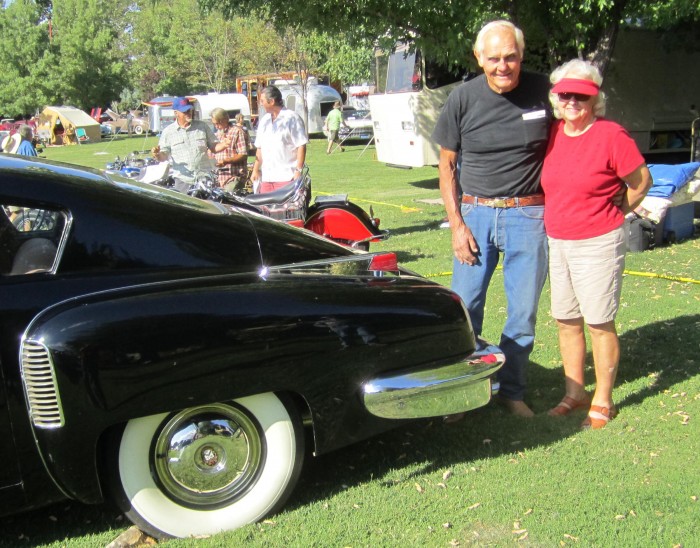
Gene and Colleen Clarke drive and show their Tucker regularly. Gene traded a Cord for it nearly half a century ago. Michael Lamm photo.
The second Tucker I drove belonged to Gene Clarke, a restorer and teacher in Chico, California. Clarke had converted his Tucker to coil springs, and while it handled infinitely better than Harrah’s, I could still feel side gusts affecting steering at freeway speeds. The rear engine caused mild oversteer. Without further development, such a car, in my opinion, would have been a handful on ice or wet pavement.
The third Tucker belonged to Bill Hamlin of Ontario, California. Bill was an aircraft mechanic. He’d again installed steel coils all around, and he’d hopped-up the engine. This car ran like a deer, well over 100 MPH, and while it handled better than Clarke’s, it still didn’t take much steering input to cause an uneasy feeling of oversteer.
Today, 47 of the original 51 Tucker prototypes remain, and restored examples fetch over a million dollars. A New Jersey entrepreneur, Rob Ida, announced in 2001 that he planned to offer a fiberglass Tucker replica, fondly called the Glass Goose, and he has so far built several on various chassis. Ida is now working on an aluminum replica of the Tin Goose. And, of course, Francis Ford Coppola, in his 1988 movie, made Preston Tucker a martyr.
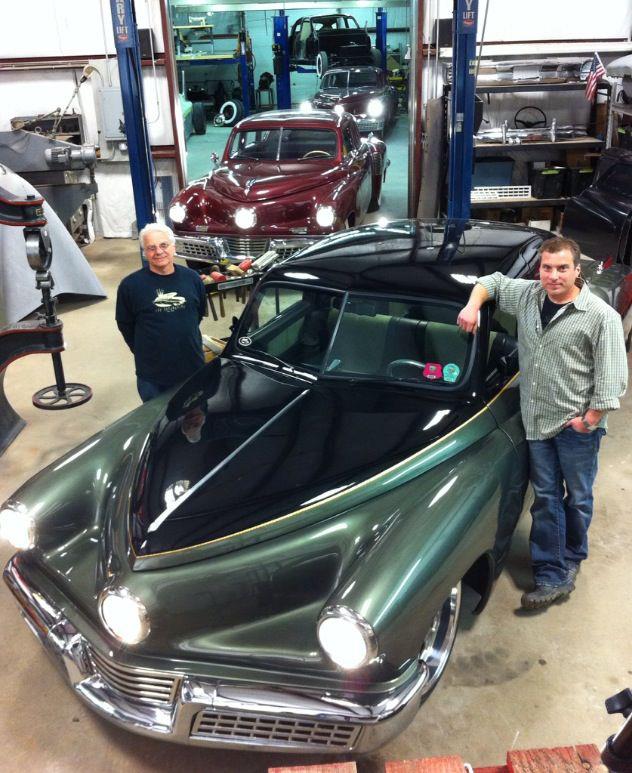
New Jersey constructor Rob Ida has built several fiberglass Tucker replicas, which he calls the Glass Goose. Rob Ida photo.
The truth is, though, that Detroit didn’t cause the Tucker’s demise any more than it caused the downfall of Kaiser-Frazer. Preston Tucker simply lacked funding, a fact exacerbated by the SEC and bad press.
——————-
1948 Tucker Data
Base price (projected): $2,450
Type of car: Rear-engine, rear-drive, 4-door, 6-passenger sedan
Engine: 6-cylinder, horizontally opposed, ohv, 334.l-cubic-inch (5.5-liter)
Horsepower & torque: 166 @ 3200 RPM (gross), 37- lb.ft @ n.a. RPM
Transaxle: 4-speed manual with Bendix vacuum-electric pre-selector (Cord sourced)
Dimensions
Wheelbase: 128.0 in.
Overall length: 219.0 in.
Curb weight: 4235 lb.





.gif)


I saw a white one at the Smithsonian years ago. Amazing seeing it in person! Thanks for the true history on the vehicle. There was a guy in norther Virginia who had the largest private collection of Tucker stuff around. You could schedule a viewing but I never got around to it. The gentelman passed away several years ago and I assume the collection was auctioned off. Incidentally, why was white not a common color until the ’50s?
Because white would yellow over time and when they finally got around to adding the proper stabilizers to the color it took years to convince the public.